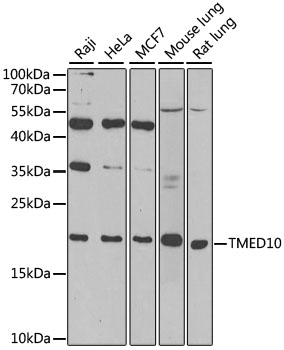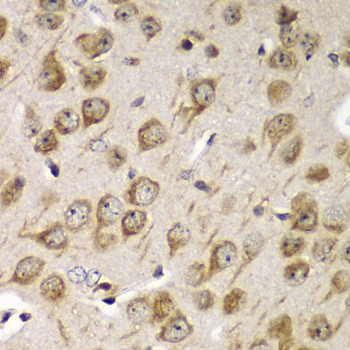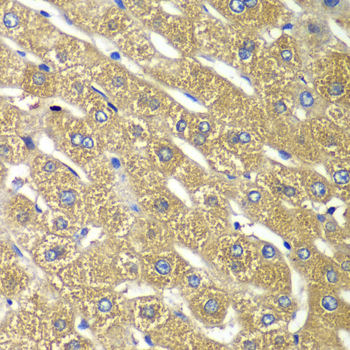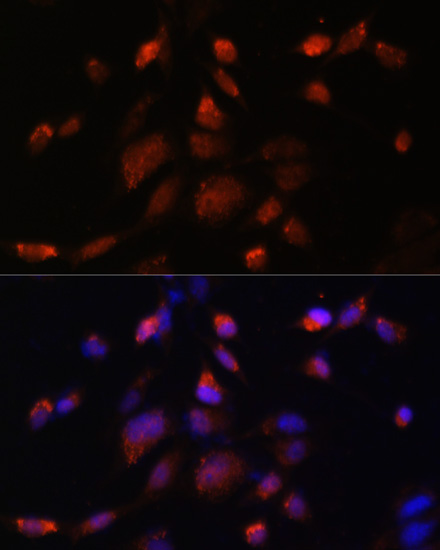Cell Biology Antibodies 10
Anti-TMED10 Antibody (CAB6771)
- SKU:
- CAB6771
- Product Type:
- Antibody
- Reactivity:
- Human
- Reactivity:
- Mouse
- Reactivity:
- Rat
- Host Species:
- Rabbit
- Isotype:
- IgG
- Antibody Type:
- Polyclonal Antibody
- Research Area:
- Cell Biology
Description
| Antibody Name: | Anti-TMED10 Antibody |
| Antibody SKU: | CAB6771 |
| Antibody Size: | 20uL, 50uL, 100uL |
| Application: | WB IHC IF |
| Reactivity: | Human, Mouse, Rat |
| Host Species: | Rabbit |
| Immunogen: | Recombinant fusion protein containing a sequence corresponding to amino acids 35-190 of human TMED10 (NP_006818.3). |
| Application: | WB IHC IF |
| Recommended Dilution: | WB 1:500 - 1:2000 IHC 1:50 - 1:200 IF 1:50 - 1:200 |
| Reactivity: | Human, Mouse, Rat |
| Positive Samples: | Raji, HeLa, MCF7, Mouse lung, Rat lung |
| Immunogen: | Recombinant fusion protein containing a sequence corresponding to amino acids 35-190 of human TMED10 (NP_006818.3). |
| Purification Method: | Affinity purification |
| Storage Buffer: | Store at -20'C. Avoid freeze / thaw cycles. Buffer: PBS with 0.02% sodium azide, 50% glycerol, pH7.3. |
| Isotype: | IgG |
| Sequence: | HLPI NSRK CLRE EIHK DLLV TGAY EISD QSGG AGGL RSHL KITD SAGH ILYS KEDA TKGK FAFT TEDY DMFE VCFE SKGT GRIP DQLV ILDM KHGV EAKN YEEI AKVE KLKP LEVE LRRL EDLS ESIV NDFA YMKK REEE MRDT NEST NTRV LYFS |
| Gene ID: | 10972 |
| Uniprot: | P49755 |
| Cellular Location: | Cell membrane, Cytoplasmic vesicle, Endoplasmic reticulum membrane, Endoplasmic reticulum-Golgi intermediate compartment membrane, Golgi apparatus, Melanosome, Single-pass type I membrane protein, cis-Golgi network membrane, secretory vesicle membrane, trans-Golgi |
| Calculated MW: | 24kDa |
| Observed MW: | 21kDa |
| Synonyms: | TMED10, P24(DELTA), S31I125, S31III125, TMP21, Tmp-21-I, p23, p24d1 |
| Background: | This gene is a member of the EMP24/GP25L/p24 family and encodes a protein with a GOLD domain. This type I membrane protein is localized to the plasma membrane and golgi cisternae and is involved in vesicular protein trafficking. The protein is also a member of a heteromeric secretase complex and regulates the complex's gamma-secretase activity without affecting its epsilon-secretase activity. Mutations in this gene have been associated with early-onset familial Alzheimer's disease. This gene has a pseudogene on chromosome 8. |
| UniProt Protein Function: | TMED10: Involved in vesicular protein trafficking. Mainly functions in the early secretory pathway. Thought to act as cargo receptor at the lumenal side for incorporation of secretory cargo molecules into transport vesicles and to be involved in vesicle coat formation at the cytoplasmic side. In COPII vesicle-mediated anterograde transport involved in the transport of GPI-anchored proteins and proposed to act togther with TMED2 as their cargo receptor; the function specifically implies SEC24C and SEC24D of the COPII vesicle coat and lipid raft-like microdomains of the ER. Recognizes GPI anchors structural remodeled in the ER by PGAP1 and MPPE1. In COPI vesicle-mediated retrograde transport involved in the biogenesis of COPI vesicles and vesicle coat recruitment. On Golgi membranes, acts as primary receptor for ARF1-GDP which is involved in COPI-vesicle formation. Increases coatomer-dependent GTPase-activating activity of ARFGAP2. Involved in trafficking of G protein-coupled receptors (GPCRs). Regulates F2LR1, OPRM1 and P2RY4 exocytic trafficking from the Golgi to the plasma membrane thus contributing to receptor resensitization. Involved in trafficking of amyloid beta A4 protein and soluble APP-beta release (independent of modulation of gamma-secretase activity). As part of the presenilin-dependent gamma-secretase complex regulates gamma-cleavages of the amyloid beta A4 protein to yield amyloid-beta 40 (Abeta40). Involved in organization of the Golgi apparatus. Predominantly homodimeric and to lesser extent monomeric in endoplasmic reticulum. Homodimer and monomer in endoplasmic reticulum-Golgi intermediate compartment and cis-Golgi network. Probably oligomerizes with other members of the EMP24/GP25L family such as TMED2, TMED7 and TMED9. Interacts with TMED2. Associates with the COPI vesicle coat (coatomer); TMED10:TMED2 heterotetramers are proposed to be involved in coatomer association. Interacts (via C-terminus) with COPG1; the interaction involves dimeric TMED10. Interacts with ARF1 (GDP- bound); the interaction probably involves a TMED10 oligomer. Interacts with SEC23A; indicative for an association of TMED10 with the COPII vesicle coat. Interacts with CD59, SEC24B, SEC24C and SEC24D. Interacts with MPPE1/PGAP5. Interacts with F2LR1. Interacts with KDELR2; the interaction is disrupted by KDELR2 ligand. Found in a complex composed at least of SURF4, TMED2 and TMED10. Associates with the presenilin- dependent gamma-secretase complex. Ubiquitous. Belongs to the EMP24/GP25L family. |
| UniProt Protein Details: | Protein type:Motility/polarity/chemotaxis; Membrane protein, integral Chromosomal Location of Human Ortholog: 14q24.3 Cellular Component: Golgi apparatus; endoplasmic reticulum membrane; zymogen granule membrane; ER-Golgi intermediate compartment membrane; cis-Golgi network; endoplasmic reticulum; secretory granule membrane; ER-Golgi intermediate compartment; integral to membrane; Golgi membrane; COPI-coated vesicle; trans-Golgi network transport vesicle; plasma membrane; melanosome Molecular Function:protein binding; syntaxin binding; protein complex binding Biological Process: COPII coating of Golgi vesicle; response to alkaloid; regulated secretory pathway; intracellular protein transport; ER to Golgi vesicle-mediated transport; vesicle targeting, to, from or within Golgi; COPI coating of Golgi vesicle; retrograde vesicle-mediated transport, Golgi to ER; kidney development; Golgi organization and biogenesis; protein oligomerization |
| NCBI Summary: | This gene is a member of the EMP24/GP25L/p24 family and encodes a protein with a GOLD domain. This type I membrane protein is localized to the plasma membrane and golgi cisternae and is involved in vesicular protein trafficking. The protein is also a member of a heteromeric secretase complex and regulates the complex's gamma-secretase activity without affecting its epsilon-secretase activity. Mutations in this gene have been associated with early-onset familial Alzheimer's disease. This gene has a pseudogene on chromosome 8. [provided by RefSeq, Jul 2008] |
| UniProt Code: | P49755 |
| NCBI GenInfo Identifier: | 3915893 |
| NCBI Gene ID: | 10972 |
| NCBI Accession: | P49755.2 |
| UniProt Secondary Accession: | P49755,Q15602, Q16536, Q86TC2, Q86TS5, B2R605, |
| UniProt Related Accession: | P49755 |
| Molecular Weight: | 219 |
| NCBI Full Name: | Transmembrane emp24 domain-containing protein 10 |
| NCBI Synonym Full Names: | transmembrane emp24-like trafficking protein 10 (yeast) |
| NCBI Official Symbol: | TMED10 |
| NCBI Official Synonym Symbols: | p23; TMP21; S31I125; Tmp-21-I; S31III125; P24(DELTA) |
| NCBI Protein Information: | transmembrane emp24 domain-containing protein 10; p24delta; p24delta1; p24 family protein delta-1; transmembrane protein Tmp21; 21 kDa transmembrane trafficking protein; 21 kDa transmembrane-trafficking protein |
| UniProt Protein Name: | Transmembrane emp24 domain-containing protein 10 |
| UniProt Synonym Protein Names: | 21 kDa transmembrane-trafficking protein; S31III125; S31I125; Tmp-21-I; Transmembrane protein Tmp21; p23; p24 family protein delta-1; p24delta1; p24delta |
| Protein Family: | Transmembrane protein |
| UniProt Gene Name: | TMED10 |
| UniProt Entry Name: | TMEDA_HUMAN |







![Anti-TMED10 Antibody (CAB18090)[KO Validated] Anti-TMED10 Antibody (CAB18090)[KO Validated]](https://cdn11.bigcommerce.com/s-rd6ounxcu2/images/stencil/590x590/products/55230/59973/anti-tmed10-antibody-cab18090ko-validated__74113__50256.1706529210.jpg?c=1)



